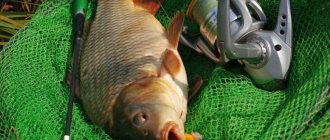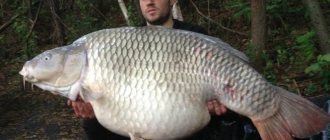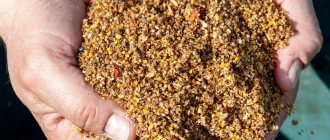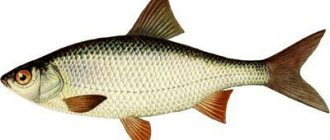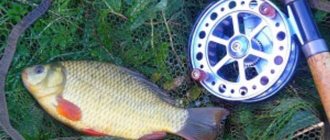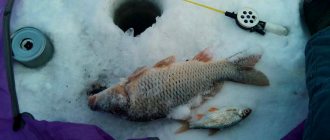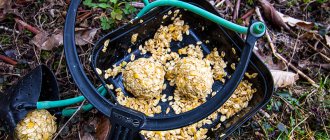Carp and carp are close relatives, but they can often be found in the same body of water; they have almost the same appearance and lifestyle. Both are popular fisheries because their meat tastes great. But a fisherman who purposefully fishes for cyprinids should know how carp differs from carp, and carp from crucian carp and grass carp, and understand the behavioral characteristics of these fish.
There are quite a lot of carp fish and some species are very similar, but there are differences, for example, carp differs from crucian carp in the presence of mustaches, this important difference will help to identify small carp and large crucian carp
This will make fishing more conscious and professional, and identification of the catch simple and clear.
General information about carp and carp: differences in appearance with photos of the “main” representatives of carp
Carp is a domesticated species of carp, that is, in this case, almost identical fish are considered, which belong to the group of cyprinids - Cyprinus carpio.
Carp in all its glory...
And no less beautiful carp - a driven wild carp that prefers current and depth
Both species can grow to quite impressive sizes - you can find specimens weighing more than 40 kg, but the population is mainly represented by fish weighing up to 5-9 kg. Sexual maturity begins at approximately 3 years of age.
Carp and carp mainly lead a bottom lifestyle, having a similar diet, which most often consists of vegetation, but the fish do not disdain animal food. They eat crustaceans, insects, and mollusks, so the characteristics of their fishing do not differ significantly. Both have an excellent sense of smell and focus primarily on it when searching for food.
At the top of their mouth they have a pair of small antennae that act as taste buds. They are most active in warm water; in winter they hardly feed, they go to pits and do not move around the pond.
The difference is clear in the photo:
Varieties of carp
The carp's body is completely covered with scales; its color will depend on the habitat. The scales on the belly are lighter than on the back, and the contrast only intensifies with age.
Taking into account the spawning area, the following varieties are distinguished:
- Semi-passing carp . This variety is characterized by the fact that when it spawns, it travels from the seas to rivers.
- Residential . Lives in rivers or seas where rivers flow into which have fresher water. It spawns in the same places in which it lives.
Varieties of carp
Human selective selection pursued the task of developing from carp a type of fish that could be easily bred on a commercial scale. This is how carp appeared.
There are such varieties of this fish:
- Naked carp . There are practically no scales on the body of this fish, which is why it differs from mirror and ordinary carp. It is not found so often, but it is a poorly adapted subspecies for living in an environment that is as close as possible to the natural one.
- Mirror . The difference between a mirror carp and a regular carp is the absence of scales on the main part of the body - they are located on the back, near the gills, tail and along the midline of the body. It is also not often found, and it is generally smaller in size, unlike the usual one.
- Common (scaly). This subspecies is very similar to carp, since their appearance has a lot in common - the carp has scales all over its body, its color significantly depends on living conditions - from golden to bright brownish.
Varieties of carp
Difference in appearance
One way or another, there are ways in which carp differ from carp in appearance. If you look closely, you can see that the carp has a more elongated body, which is explained by its living conditions - the fish mainly chooses rivers with a current, in which it is necessary to overcome significant resistance while searching for food.
Moreover, carp grow in length much longer, unlike carp, since the latter, upon reaching a certain size, further increases in width. With the same weight, carp is much longer than carp. All the scales of the carp are dark, while those of the carp are of a uniform light color.
Important: The carp's head is disproportionately large compared to its body. A professional fisherman certainly knows how exactly one can distinguish carp from carp by appearance, taking this feature into account.
Also, the big difference between carp and carp is the presence of a small tubercle near the base of the head in the former, while the wild species does not have it.
What is the difference between carp and carp, detailed video educational program:
General description of the carp family
The main feature of the carp family is that their body structure completely lacks a stomach, which is why this type of fish is in constant search of food. Cyprinids are relatively large in size for inhabitants of freshwater rivers. The length of large individuals can vary from thirty centimeters to one meter, and the weight of such fish reaches 20 kilograms. In rare cases, specimens up to one and a half meters long and weighing thirty-five kilograms are found. This species of fish lives up to thirty-five years, but length and weight gain occur in the first half of its life.
The body of carp and carp is covered with scales from head to tail, but there are subspecies that have very few of them and are located only in the upper part of the body. The color of the fish depends entirely on where they live, and can be light golden or brown.
Carp and carp have an excellent sense of smell, which makes it possible to detect minor vibrations of bloodworms or other larvae in the water even at a ten-meter distance. The upper lip has two pairs of thick whiskers, which are taste receptors.
The fish's head is round and blunt in shape. The mouth is large, retractable, with fragile lips (if you make too sharp a hook during fishing, they will remain on the hook). The mouth cavity contains teeth, thanks to which the fish can chew various plants and small larvae or insects.
The fish matures for reproduction at the age of four years, with males entering this period slightly earlier than females. For spawning, carp choose places that are rich in algae. When the temperature rises to twenty degrees, the fish begins to spawn. A few days after spawning, the eggs become fry.
Differences in behavior and habits
The carp primarily lives in its natural environment, this is reflected in its behavior. The fish is much more careful, unlike the carp, since it has many enemies in the rivers, while the second does not need to hide from predators for the entire first year of life. That is, when fishing for carp, it is necessary to more carefully observe the silence regime and choose the right camouflage.
The daily diet of these fish is also slightly different - carp in the spring often feeds on the eggs of other fish species, and in some cases, if there is very little food in the reservoir, it does not disdain even fry. At the same time, carp prefer to feed on vegetation, this is due to artificial feeding in the ponds where this fish is grown.
During selection, carp acquired such a distinctive feature as increased fertility, while carp have much fewer eggs during the spawning period, and they are much more demanding of spawning conditions.
Places of residence
The habitats of these two types of fish are also different. Carp is not so demanding on the presence of oxygen in a reservoir; 5 mg per liter of water is enough for it; this allows the fish to live and grow well even in small ponds where the water is stagnant. At the same time, carp is much more sensitive to the presence of oxygen - this fish needs at least 8 mg per liter of water, which is why it chooses rivers with strong currents.
Carp is much more heat-loving, unlike carp, and is more common in the southern regions. The optimal temperature for it in the reservoir is 26 degrees Celsius higher, and closer to the southern regions its population is much larger than carp. The latter can live at lower temperatures.
Carp can be easily identified by its habitat; unlike carp, it cannot be found in stagnant bodies of water.
Fishing features: differences in the behavior of carp and crucian carp
There are the following differences in the behavior of these two types of fish that should be taken into account when fishing .
- Carp is more careful - it has sensitive hearing, so it is afraid of unnecessary noise . This should definitely be remembered when fishing - carp can be frightened by even a strong splash when casting a tackle.
- The carp also carefully approaches the bait site - despite the fact that the crucian carp immediately pounces on it, the carp can stand at a distance without the risk of approaching directly to the bait site .
- Small and medium-sized crucian carp often gather in schools and thus drift around the reservoir in search of food , while carp prefers to swim either in small groups of up to 6-8 individuals , or to swim and look for food alone .
- Carp and crucian carp offer different resistance when fishing. The carp behaves much more aggressively makes sharp jerks , and moves more quickly to the side, while its relative actively resists only in the first seconds .
With attention to detail, it is quite easy to distinguish a caught carp from a crucian carp - especially knowing what exactly it is worth emphasizing . It should be remembered that it would be somewhat unreasonable a carp weighing less than 0.5 kg , given that in a couple of years its size will be several times larger .
The difference between carp and grass carp (carp of love)
Although cupid also belongs to the carp fish, there are still certain differences with carp. The main difference between grass carp is that its body is much longer, its head is flattened, there are stripes on its gills, and its eyes are framed in yellow.
Grass carp can grow up to 130 cm in length and weigh over 50 kg; it grows faster and can already reach a length of 80 cm at the age of 7-8 years, at which time it begins to spawn.
Grass carp is driven and can grow up to half a hundredweight
General information
Carp , living in slowly flowing or stagnant waters of rivers and lakes, belongs to the Cyprinidae. It is a heat-loving fish. It feeds on worms, mollusks, small crustaceans. Breeding of this fish is very common. Carp has earned its popularity due to its fertility and rapid growth.
Carp
Crucian carp is a biological relative of carp, since it belongs to the same cyprinids. This is an unpretentious fish; it loves reservoirs with muddy bottoms and mud. In such an environment, crucian carp feed on organic debris and small invertebrates. Crucian carp is very tenacious. Buried in silt, it does not die, even when in winter the reservoir freezes to the bottom.
crucian carp
What is the difference between carp and carp and crucian carp
First of all, what you should pay attention to when looking for differences is that carp are characterized by the presence of mustaches, while crucian carp do not have them.
Also, the structure of the head of crucian carp is simpler, without a tubercle near the base. The carp's lips are much fleshier than those of its younger relative.
The body of the carp is wide, while that of the crucian carp is taller and narrower. Also, carp grow much larger in size, and the weight of adult specimens significantly exceeds even very large crucian carp.
The main difference between carp and crucian carp is the head; in wild carp it is much more massive and disproportionate to the body than in crucian carp. At the same time, the carp has a larger mouth, the lips are compacted and yellowish in color.
The most distinctive feature, as in the case of carp, is the presence of small antennae that grow from the corners of the mouth. In crucian carp they are completely absent.
The carp has a low-slung body, while the crucian carp has a high body shape. The dorsal fin of the second is small in size and almost even, while the dorsal fin of the first is much longer.
